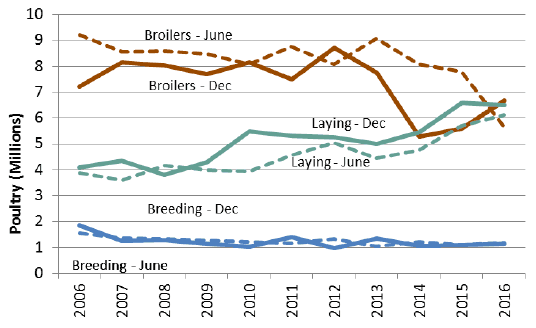Scottish agricultural survey: December 2016
Annual agricultural survey based on data from larger agricultural holdings together with estimates for smaller farms.
This document is part of a collection
8. Poultry
Year-on-year comparisons between 2015 and 2016 December Survey results show:
- An increase in the total number of poultry of 1.00 million (7.5 per cent) to 14.42 million - similar to the 8.1 per cent annual increase reported in the 2016 June Census results. The December figure is four per cent higher than the ten year average of 13.81 million.
- An increase in the number of broilers of 1.07 million (19.1 per cent) to 6.67 million - larger than the 14.9 per cent increase reported in the 2016 June Census results. The figure is 9.2 per cent lower than the ten year average of 7.35 million.
- A decrease in birds for laying eggs for eating of 90,000 (1.4 per cent), with the number of layers falling to 6.51 million - compared with a 3.5 per cent increase in the 2016 June Census results. The figure is 25 per cent higher than the ten year average of 5.21 million.
- An increase in breeding birds of 56,000 (5.1 per cent), with the number rising to 1.15 million - larger than the 0.3 per cent increase reported in the 2016 June Census results. The figure is 2.4 per cent lower than the ten year average of 1.17 million.
→ Insight
Significant restructuring in the broiler industry resulted in poultry numbers decreasing markedly in 2014/15, but then recovering in 2016. In the longer term, layer numbers have been increasing, with, in 2015, layers outnumbering broilers. (Contrast this with 2008 when there were 8.0 million broilers to 3.8 million layers). In 2016, broiler numbers recovered, exceeding layers in both the June and December counts. These changes have also been reflected in the income figures published in January.
Chart 9 shows trends over the past ten years from the December Survey and June Census for broilers (used for meat production), laying fowls (used for egg production) and breeding birds (used to produce broiler and layer chicks). It should be noted that there is some inherent variability in the annual poultry data, which can be affected by short-term operational factors.
For some years, the chart shows large differences in the number of broilers and layers between June and December. This variability can occur if large poultry units reduce the number of birds on their holdings over the survey date, for operational reasons such as the cleaning of premises. Also the poultry production cycle is very short compared to other livestock, which provides producers with the flexibility required to change production levels in response to market conditions.
Over the past ten years total poultry numbers have fluctuated around 14 million. However since 2013 there has been a drop in the number of broilers, and an increase in the number of poultry for laying eggs.
Chart 9: Poultry, June and December 2006 to 2016

Broilers fluctuated around 8 million until 2013, since when broiler numbers fell. There were 6.67 million broilers in December 2016.
The figures for laying fowls had been steady at about four million until 2009, before increasing noticeably to over five million in 2010, a level which was maintained through 2013, before increasing again recently. Over the ten year period the December Survey results show an increase of 2.42 million (59 per cent).
The trends in the annual number of breeding birds have been fairly constant with the December Survey and June Census both averaging about 1.2 million birds over the ten year period.
Contact
Email: agric.stats@gov.scot
There is a problem
Thanks for your feedback